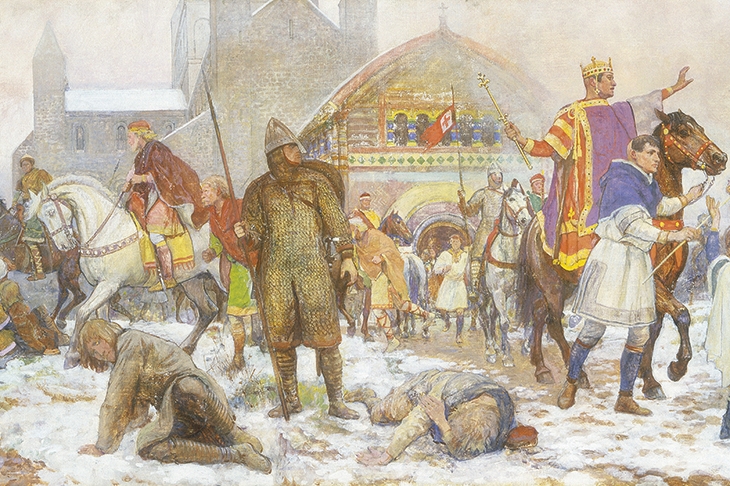When Bishop Guy of Amiens looked across the Channel in the 11th century he saw ‘teeming London [which] shines bright. A most spacious city, full of evil inhabitants, and richer than anywhere else in the kingdom’. Well, plus c’est la même chose.
Even then those Mammonic associations were already old. Over 300 years earlier the Venerable Bede had called London an ‘emporium of many nations who visit it by land and sea’ — a place of markets and mints, of North Sea slave-traders and missionaries seeking martyrdom east of the Rhine, of wine and wool merchants trying to make ends meet. The hubbub and hum of the city had begun.
London of the early middle ages has — like much early medieval history — often been ignored. Peter Ackroyd’s magnificently successful London: The Biography dedicated 11 of its 800 pages to the six centuries between the fall of Rome and the Norman Conquest — akin to breezing over the period between the murder of Edward II and the Suez crisis. To be fair, such abbreviations derive from the profound ambiguity or absence of sources. Between 400 and 1000 written material on London is scarce and the archaeology confusing and incomplete. Step forward Rory Naismith to mind the gaps.
At Cambridge Naismith was something of a wunderkind who published his first paper whilst still an undergraduate. Now an established academic at King’s College London, he has an almost unmatched knowledge of how early English money worked — the production, design, regulation and circulation of pennies, shillings and the like. This particular skill is married to an expert understanding of the disparate archaeology and texts of the period — essential disciplines for grappling with the oddities of medieval England.
For a long time early Anglo-Saxon London posed a conundrum. Whenever the Square Mile was excavated, the diggers and scrapers came back with the same answer: after the collapse of the Roman city in the fifth century there were no identifiable remains until a sudden boom in the 900s. Some archaeologists asserted that either Bede had been referring to a sort of fayre rather than a settlement, or that he had been mistaken. It was only when others began to consider finds from the somewhat tellingly named Aldwych (‘old town’) that the truth emerged. Anglo-Saxon Lundenwic had grown up to the west of the Roman city’s wreckage along the Strand — a beach market (suitably enough, beneath the history department of King’s College London). There merchants flourished until the late ninth century when, beset by Viking armies, the remaining Roman walls began to look inviting.
Thus sheltered, the foundations of the future city were laid. If Britain has a natural capital, it is York; but London is a supraregional hub whose hinterland reaches far beyond the island. The mouth of the Thames faces those of the Scheldt and the Rhine, leading to their beer and quern stones, gold brooches and silver coins. And the Thames opens up also to the wide sea and distant worlds of Byzantine silks and arctic furs. To pay for such luxuries the English sold produce in bulk — principally wool, which so famously fuelled the success of the later medieval nation.
Anglo-Saxon England’s prosperity was born of the ability of government to protect, harness, exploit and so accelerate this burgeoning commerce. As the administration did so, it developed and Naismith shows how various long-lived London institutions — the Court of Husting, the wards of the city, early forms of guilds — came into being at this time.
Though not yet the formal capital, London on the eve of the Norman Conquest held an exaggerated status within the realm. In 1016, on the death of Æthelred the Unready, it was the burhwaru (citizens) of London who chose his son Edmund Ironside as king. Two years later, when Cnut exacted tribute from his conquered nation, London paid £10,500 — as opposed to the rest of the kingdom’s £72,000, suggesting that the city may have made up nearly 13 per cent of England’s economy (compared to about 26 per cent today). It was in London that nobles and abbots from afar kept houses alongside each other and it was at Westminster that Edward the Confessor chose to build his vast royal abbey, 100m in length, to rival the greatest churches of northern Europe. And when William’s bloody conquest came, it was his coronation in the city that sealed it.
Naismith’s service to old London is heroic. In carefully sorting and untangling its post-Roman rebirth he allows a crucial phase in its long life to take its rightful place in the annals of the great and monstrous city.






Comments